| Article ID | Journal | Published Year | Pages | File Type |
|---|---|---|---|---|
| 4732297 | Journal of Asian Earth Sciences | 2007 | 9 Pages |
The thermal structure of two Himalayan glacial lakes, Tsho Rolpa and Imja in the eastern Nepal, was examined by observations in the pre-monsoon seasons of 1996 and 1997. Tsho Rolpa had an isothermal mixed layer at water depths of 0–20 m, whereas Imja did not possess such an isothermal layer. This difference in the thermal structure is explained by the condition that diurnal valley winds, producing wind-driven currents, blow strongly near the water surface of Tsho Rolpa, but very weakly near that of Imja. The wind observations above or near the end moraine indicated that a daily wind system of strong, diurnal valley winds and weak, nocturnal mountain winds is common to the lakes. It was suggested that with respect to the valley winds, the weak winds near the surface of Imja result from topographic screening effects of the upwind dead-ice zone and end moraine 20–25 m higher than the water surface. In order to ascertain the topographic effects, three-dimensional numerical simulation of airflow was carried out by making topographic models of actual size in the calculation domain, corresponding to Tsho Rolpa and Imja and their surrounding topography. The simulation revealed that, when winds blow at constant velocities of 1–5 m s−1 at 2 m above the points corresponding to the weather stations, the wind velocity at 2 m above the water surface for Imja is 33–42% smaller than for Tsho Rolpa. With increasing heights of the end moraine and dead-ice zone, the wind velocity near the lake surface efficiently decreased by decreasing the lake length from 3.1 or 2.2 km to 1.2 km.
